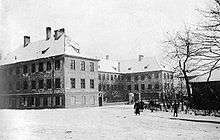Seidenhauskaserne

The Seidenhauskaserne (literally silk house kaserne), also called Artillerie-Kaserne,[1] was a smaller military facility of the Bavarian army, located at Hofgarten Strasse 1 in Munich, Germany, which existed from 1808 until 1899.
History
Because the existing barracks of the Munich garrison had an unfavourable tactical location, and some of them fell into disrepair, in 1803 the Bavarian army rented the old court silk factory building to accommodate their artillery troops in the south-eastern corner of the Hofgarten at the northern outskirts of old Munich,[2] nearby the new Hofgartenkaserne, which was under construction since 1801.
Due to the epidemic of typhoid in the Hofgarten- and the Seidenhauskaserne in 1893, a meeting of scientists, physicians, military, engineers and representatives of the city was scheduled to clarify the reasons. Chairman of the meeting was the Bavarian minister of war Adolph von Asch. Due to a missing uniform conclusion, von Asch decided to apply for closing the barracks at prince regent Luitpold, who accepted the motion on July 18, 1893. The Seidenhauskaserne was fully evacuated in 1899.[3] The building slated for demolition in 1900 to make way for an army museum.[2]
References
- ↑ Paul Maucher: Alphabetic register of house owners 1849-1851, p. 29.
- 1 2 Seidenhauskaserne (German), City of Munich.
- ↑ Hofgartenkaserne und Seidenhauskaserne (German), in Vom Armeemuseum zur Staatskanzlei, art guide, pp. 5–8.
Coordinates: 48°08′30″N 11°34′55″E / 48.1417°N 11.5819°E